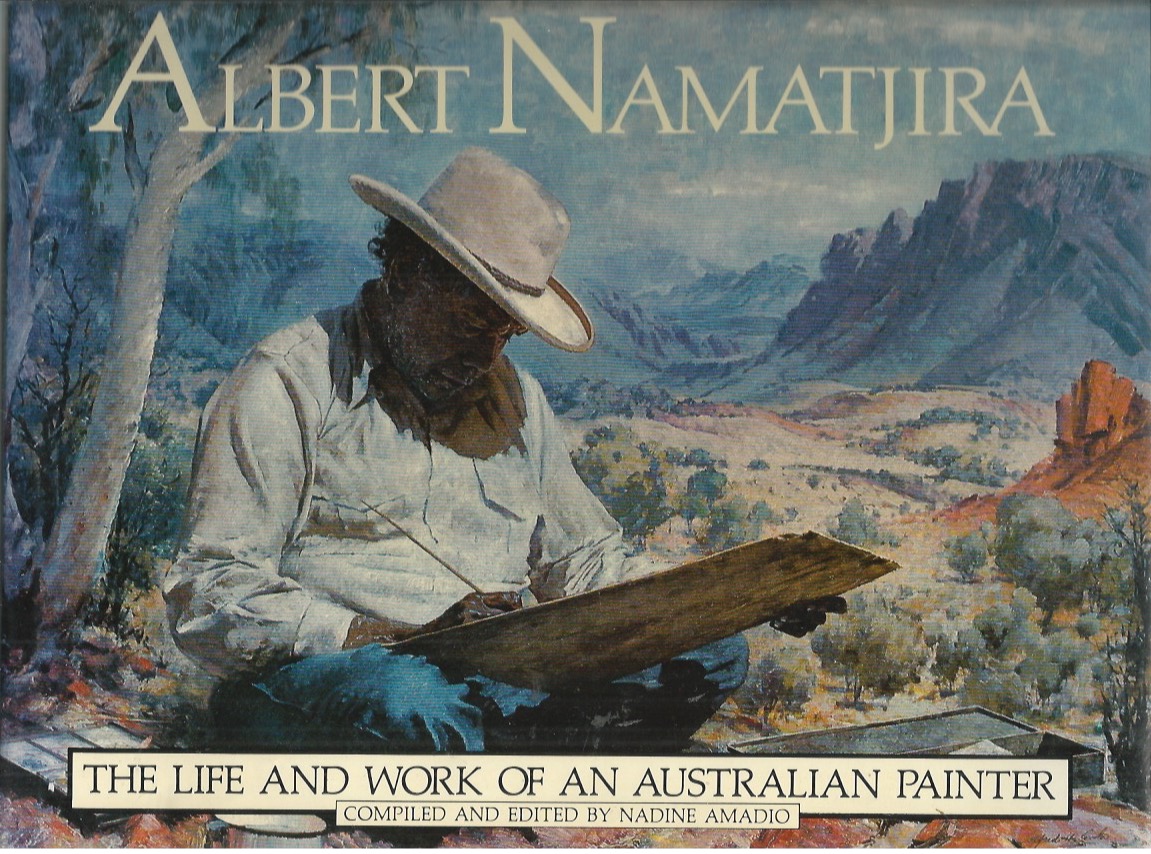AUSTRALIAN ART
Albert Namatjira (born Elea Namatjira; 28 July 1902 – 8 August 1959) was an Arrernte painter from the MacDonnell Ranges in Central Australia, widely considered one of the greatest and most influential Australian artists. As a pioneer of contemporary Indigenous Australian art, he was arguably one of the most famous Indigenous Australians of his generation. He was the first Aboriginal artist to receive popularity from a wide Australian audience.[1]
A member of the Western Arrernte people, Namatjira was born and raised at the remote Hermannsburg Lutheran Mission, 126 km west-southwest from Alice Springs. He showed interest in art from an early age but it was not until 1934 (aged 32) and under the guidance of Rex Battarbee that he began to paint seriously. Namatjira’s richly detailed, Western art-influenced watercolours of the outback departed significantly from the abstract designs and symbols of traditional Aboriginal art, and inspired the Hermannsburg School of painting. He became a household name in Australia and reproductions of his works hung in many homes throughout the nation.
In 1956, a portrait of Namatjira by William Dargie became the first of an Aboriginal person to win the Archibald Prize. Namatjira was awarded the Queen’s Coronation Medal in 1953, and was honoured with an Australian postage stamp in 1968.
Namatjira was the first recorded Northern Territory Aboriginal person to be freed from restrictions that made Aboriginal people wards of the state when he was granted British Subjecthood and Australian citizenship in 1957.[2] This gave him the right to vote in national, state and territory elections, freedom of movement and freed him from restrictions on buying alcohol but, in the Northern Territory, he still had limited land rights. However, Namatjira remained poorly treated by the government[which?]; he was sentenced to prison after leaving a bottle of rum on the back seat of his car, which was likely taken and consumed by a man who had then drunkenly beaten and killed his own wife. Public and international outcry intervened in the liability ruling and Namatjira instead served less than two months in a native reserve in Papunya.[2] He continued to live in Papunya with his wife, until he died of heart disease in an Alice Springs hospital in 1959.[3]
Described as a “monumental figure” within Australian art, Namatjira is considered one of the most talented Arrernte artists to have lived.[3] As one of the foremost painters of the Hermannsburg movement, he blended indigenous landscapes and Western-style painting techniques to “bring central Australia to life, for thousands who had never seen it for themselves.”[4] His legacy lives on through international critical acclaim, the naming of his homeland’s electorate after him, and his artistically inclined descendants. They form the artistic and memorial collective the Namatjira project, which includes his Ramsay Prize-winning great-grandson Vincent Namatjira.[5]
Namatjira was introduced to western-style painting through an exhibition by two painters from Melbourne, Rex Battarbee and John Gardner, at his mission in 1934.[6] Battarbee returned to the area in the winter of 1936 to paint the landscape, and Namatjira, expressing an interest in learning to paint, acted as his cameleer and guide to show him local scenic areas. Battarbee showed him how to paint with watercolours.[6]
Namatjira started painting in a unique style. His landscapes normally highlighted both the rugged geological features of the land in the background, and the distinctive Australian flora in the foreground with very old, stately and majestic white gum trees surrounded by twisted scrub. His work had a high quality of illumination showing the gashes of the land and the twists in the trees. His colours were similar to the ochres that his ancestors had used to depict the same landscape, but his style was appreciated by Europeans because it met the aesthetics of western art.
In his early career, Namatjira’s work included tjuringa (sacred object) designs, biblical themes and figurative subjects, and he also carved and painted various artefacts.[6]
In 1937 Friedrich Albrecht, superintendent of Hermannsburg, took ten of Namatjira’s watercolours with him to a Lutheran conference at Nuriootpa, South Australia, and Battarbee put three of his paintings in an exhibition with the Royal South Australian Society of Arts in Adelaide. In 1938, Namatjira held his first solo exhibition in Melbourne.[6]
He became the first prominent Aboriginal artist to work in a contemporary western style, and thus regarded as an example of assimilation. In 1944 he was included in Who’s Who in Australia.[6]
Subsequent exhibitions in Sydney and Adelaide also sold out.[citation needed] His work garnered wide acclaim, both in Australia and in other countries. Queen Elizabeth II became one of his more notable fans and he was awarded the Queen’s Coronation Medal in 1953 and met her in Canberra in 1954. He was elected an honorary member of the Royal Art Society of New South Wales in 1955.[6]
Not only did his own art become widely recognised, but a painting of him by William Dargie won the Archibald Prize in 1956,[9] the first painting of an Aboriginal person to win the prize.[10]
Biographical information about life and works; chapters by J. Jones, D. Thomas, A. Blackwell annotated separately.
ix, 102 p. : ill. (some col.)., ports. ; 23 x 30 cm. #040423
Namatjira, Albert, 1902-1959. | Namatjira, Albert, 1902-1959. | Landscape painters — Australia — Biography. | Landscape painting, Australian. | Art, Australian — Aboriginal artists. | Art – Artists. | Ntaria / Hermannsburg (South Central NT SF53-13)
